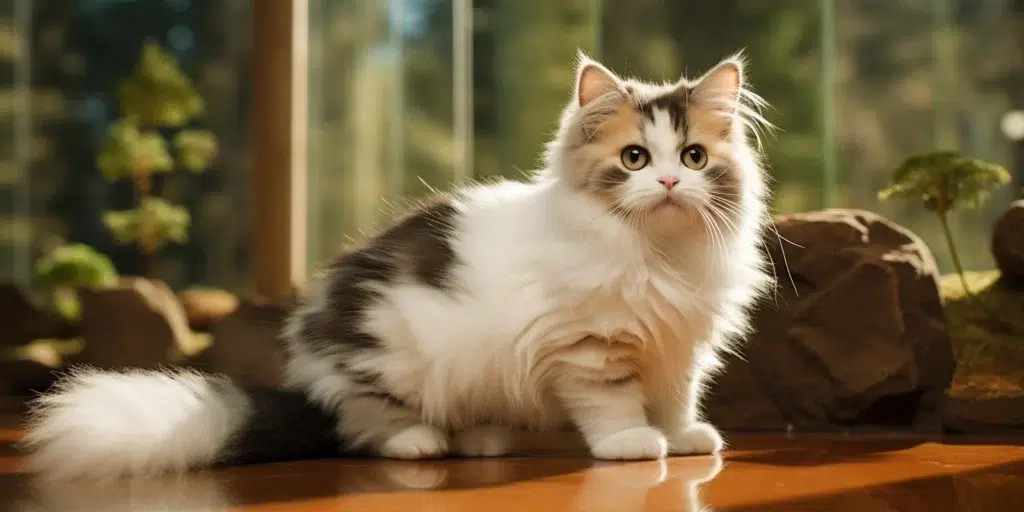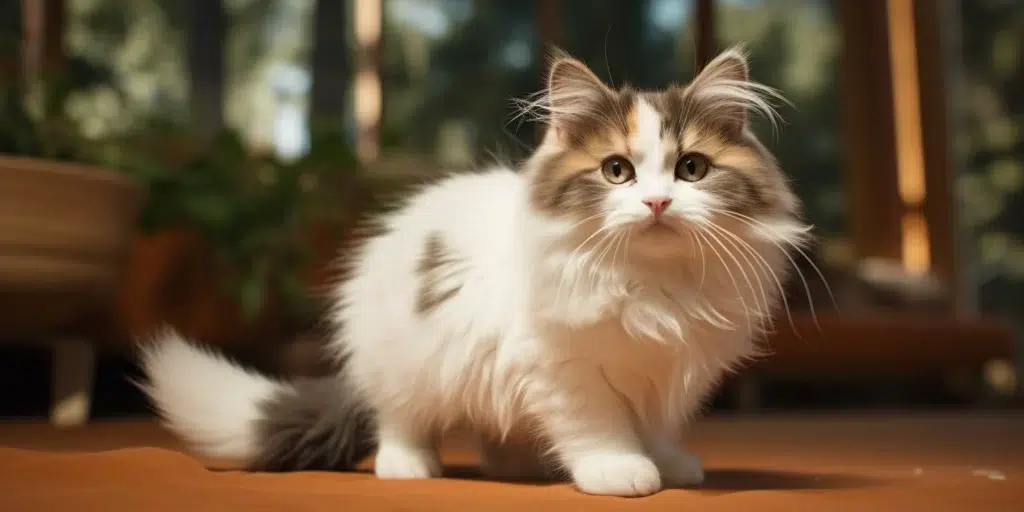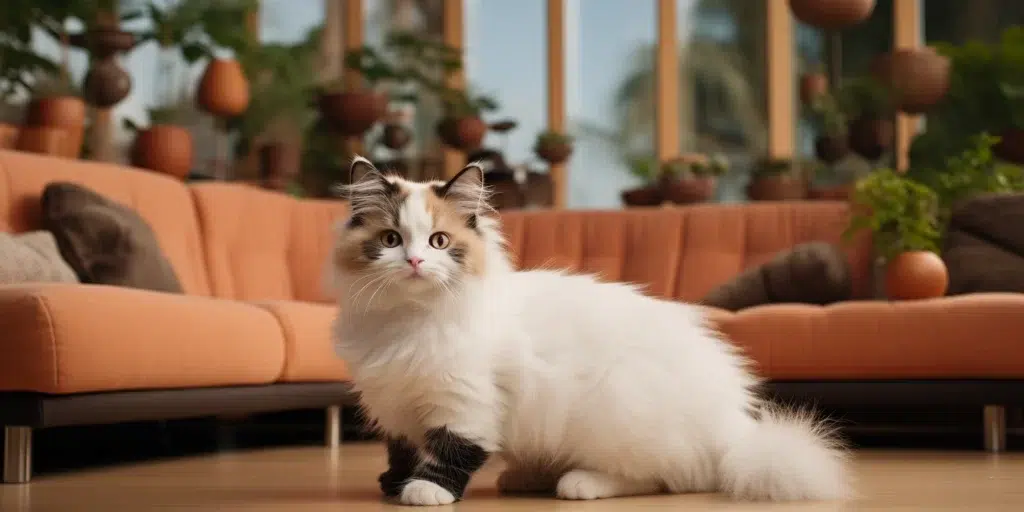Have you ever wondered how vocal Munchkin cats are? These adorable, short-legged felines are known for their distinctive appearance, but their vocalizations are just as unique and interesting.
Munchkin cats communicate in various ways, and understanding their noises can deepen the bond between you and your furry friend. In this blog post, we’ll explore the world of Munchkin cat vocal sounds, what influences their chatter, and what they’re trying to tell us.
Munchkin cats are not just cute; they have their own ways of expressing themselves. Whether they’re telling you it’s time for dinner or just saying hello, each Munchkin cat has a repertoire of sounds. Like people, each cat’s personality influences how much they “talk.”
So, if you’ve been curious about the noises your Munchkin cat makes, you’re in the right place. We’ll dive into what makes these cats vocal, the meanings behind their sounds, and how to understand them better.
Understanding the nuances of Munchkin cat noises is not just fun—it’s also important for their care. Recognizing the difference between a happy purr and a distressed meow can help you respond to your cat’s needs more effectively.
So, let’s embark on this exciting journey into the world of Munchkin cat vocal noises together!

Are Munchkin Cats Vocal Cats?
Yes and no! Munchkin cats have a unique personality that can influence their vocalization. Some Munchkin cats might be chatterboxes, while others prefer to express themselves quietly. This varies greatly from one cat to another.
Gender can play a role in how vocal a Munchkin cat is. Males, for instance, might be more inclined to vocalize during mating seasons, though in domesticated settings, this behavior can be less prominent.
Each Munchkin cat, regardless of gender, has its own set of characteristics that contribute to its vocal behavior. It’s also worth noting that individual differences are significant—some Munchkin cats might enjoy engaging in lengthy conversations with their humans, while others use their voice sparingly.
Factors That Influence Munchkin Cat Noise Levels
Activity levels can also influence how much a Munchkin cat vocalizes. More active cats might be too busy exploring and playing to make much noise, while a more laid-back Munchkin might vocalize more often, either to demand attention or just to chat about their day.
Observing your Munchkin’s daily habits can provide clues about their vocalization patterns.
Their Age
Age is a significant factor in the vocal behavior of Munchkin cats. Kittens tend to be more vocal as they are learning to communicate with their mother and siblings. They meow more often to express their needs, like hunger or discomfort.
As Munchkin cats grow into adulthood, their meowing might decrease, as adult cats typically meow less and opt for other forms of communication like body language.
However, as Munchkin cats enter their senior years, they might become more vocal again. This change can be attributed to several factors, including health issues or changes in their environment.
Older Munchkin cats might meow more due to confusion or disorientation, especially in cases of cognitive decline. Being attentive to these changes is crucial for their care.

Feeding Munchkin Cats and Its Relation to Noise Levels
Feeding time is prime time for vocalization in Munchkin cats. They quickly learn that meowing can lead to feeding, which can encourage more vocal behavior around meal times.
However, this doesn’t mean that a Munchkin cat only vocalizes when hungry.
It’s more about the association they’ve made between meowing and the positive outcome of getting fed. Understanding this can help manage mealtime vocalizations more effectively.
On the flip side, if a Munchkin cat suddenly becomes more vocal around feeding times or changes its eating habits, it might be a sign of an underlying issue. Monitoring these changes and consulting with a veterinarian can ensure your Munchkin cat stays healthy and happy.
Munchkin Cat Exercise Level Affects Their Noise Levels
Physical activity has a notable impact on the vocal behavior of Munchkin cats. Cats with regular play sessions and adequate stimulation tend to be more balanced in their vocalizations.
Engaging in play and exercise not only helps in keeping your Munchkin cat physically fit but also mentally stimulated, which can reduce excessive meowing or vocalization due to boredom or attention-seeking.
Creating a stimulating environment with toys, scratching posts, and interactive play can help keep your Munchkin cat content and potentially less vocal. Remember, a happy and engaged cat is less likely to vocalize excessively.
Medical Conditions
Health issues can significantly influence the vocal behavior of Munchkin cats. A sudden increase in vocalization or a noticeable change in the type of noise they make can be a sign of discomfort or illness.
Pain, discomfort, or conditions like hyperthyroidism can lead to increased vocalization in cats. It’s essential to pay attention to these changes and seek veterinary advice.
Regular health check-ups can help catch and address any underlying medical conditions early on. Observing and understanding your Munchkin cat’s typical vocalization patterns can be invaluable in identifying when something might be wrong.

Munchkin Cat Noises and Their Meaning
Understanding the different sounds your Munchkin cat makes is crucial for effective communication. Each noise serves a purpose and understanding them can significantly improve your relationship.
Meow (The Most Common Noise)
The meow is the most versatile sound in a Munchkin cat’s vocal arsenal. It can signify anything from hunger, greeting, discomfort, or the desire for attention.
Kittens primarily use meowing to communicate with their mothers, but adult cats continue to use it to communicate with humans. The tone, duration, and context of the meow can help determine its specific meaning.
Purring (The Most Enjoyable Cat Noise)
Purring is a soothing sound indicating contentment. However, it’s important to note that cats can also purr when in pain or distress, serving as a self-soothing mechanism.
Generally, if your Munchkin cat purrs while cuddling or being petted, it’s a sign of happiness and comfort.

Hissing (Your Cat Feels In Danger)
A hiss is a clear indication that your Munchkin cat feels threatened or is in distress. It’s a defensive noise, signaling that it’s best to give your cat some space. Understanding and respecting this boundary is essential for a harmonious relationship.
Yowl (Not a Happy Meow)
A yowl is a longer, more drawn-out sound that can indicate discomfort, loneliness, or territorial disputes with other cats. It’s essential to pay attention to these sounds, as they can signal significant distress or dissatisfaction.
Growls (Not as Scary as a Tiger)
Growling in Munchkin cats can be a warning sign of fear, discomfort, or territoriality. Like hissing, it’s an indication that it’s time to back off and provide your cat with some breathing room. Observing and respecting these vocal cues is crucial for your cat’s well-being.

Some Cats are More Talkative Than Others
Personality plays a significant role in how talkative Munchkin cats are. Some may be naturally more vocal, while others might be quieter. Environments that encourage interaction and communication can help foster a more vocal relationship with your cat.
However, it’s essential to appreciate and respect your cat’s natural communication preferences.
How to Make Munchkin Cats Less Vocal?
If excessive vocalization is an issue, there are ways to address it. First, ensure that all your Munchkin cat’s needs are met—hunger, thirst, comfort, and attention.
Consistent schedules can help reduce anxiety-driven vocalization. Engaging your cat in regular play and providing environmental enrichment can also help mitigate excessive meowing.

Conclusion
Munchkin cats have a unique way of communicating with their human companions. Understanding their vocalizations can deepen the bond between you and your furry friend. By paying attention to the factors that influence their vocal behaviors, you can ensure a happy, healthy, and harmonious relationship with your Munchkin cat.
Remember, each meow, purr, or hiss is an attempt at communication, and appreciating these efforts can only enhance the love and understanding between you and your cat.